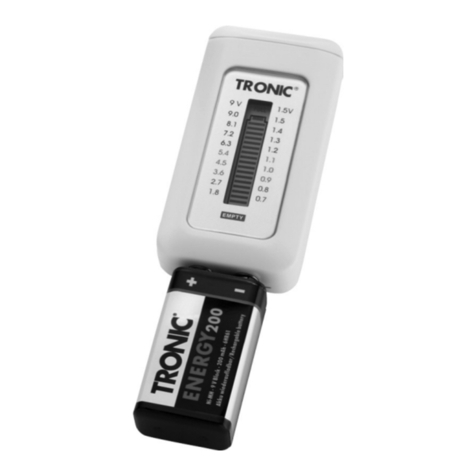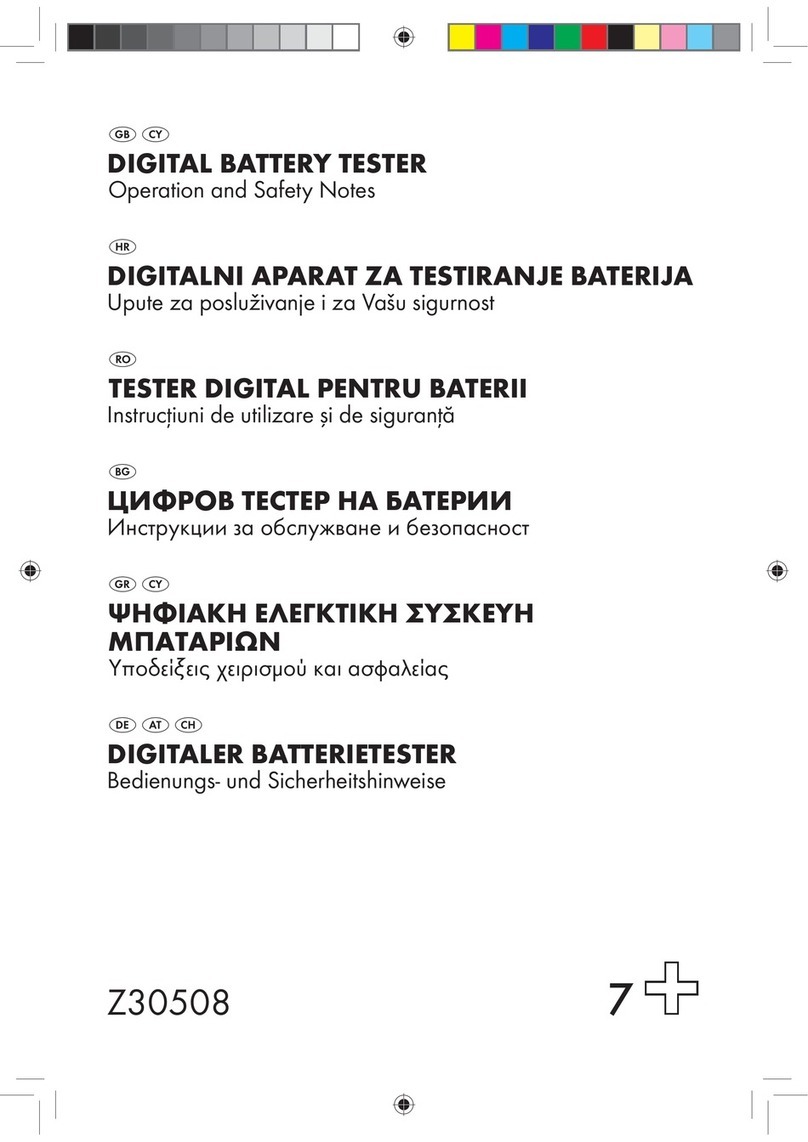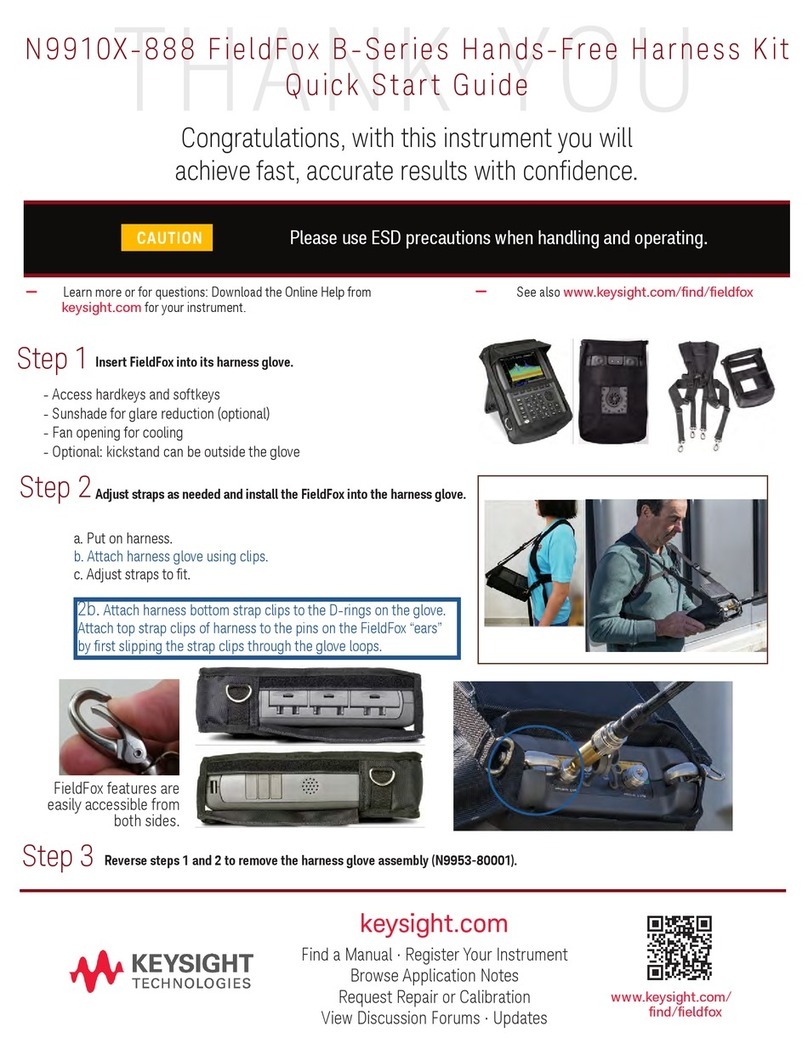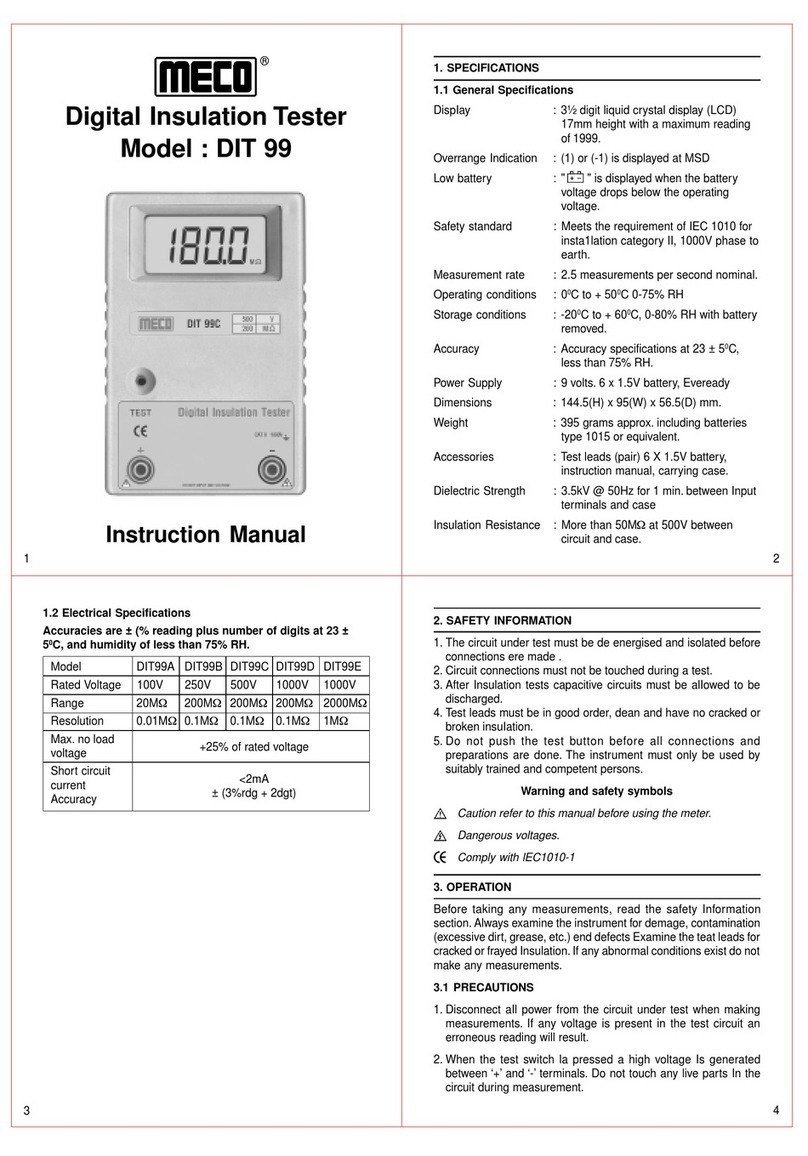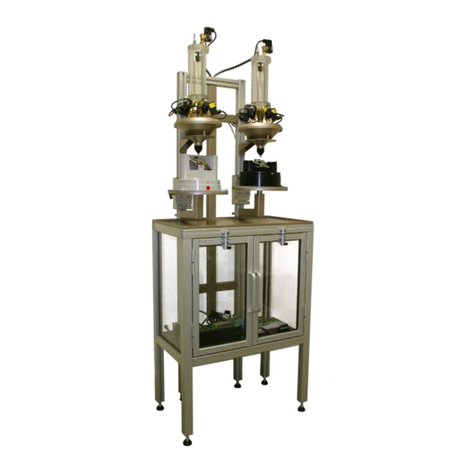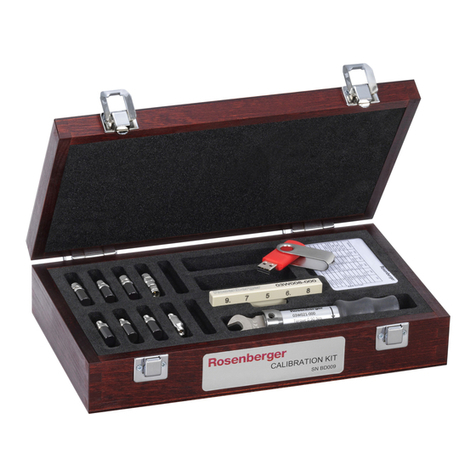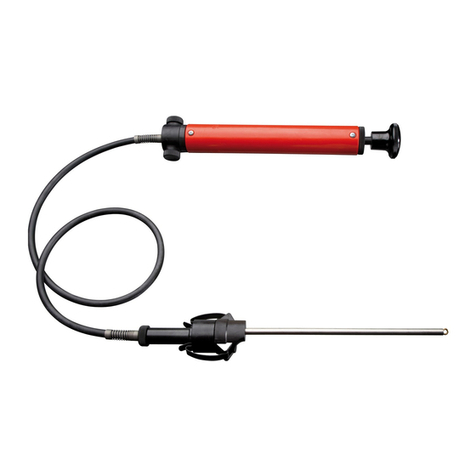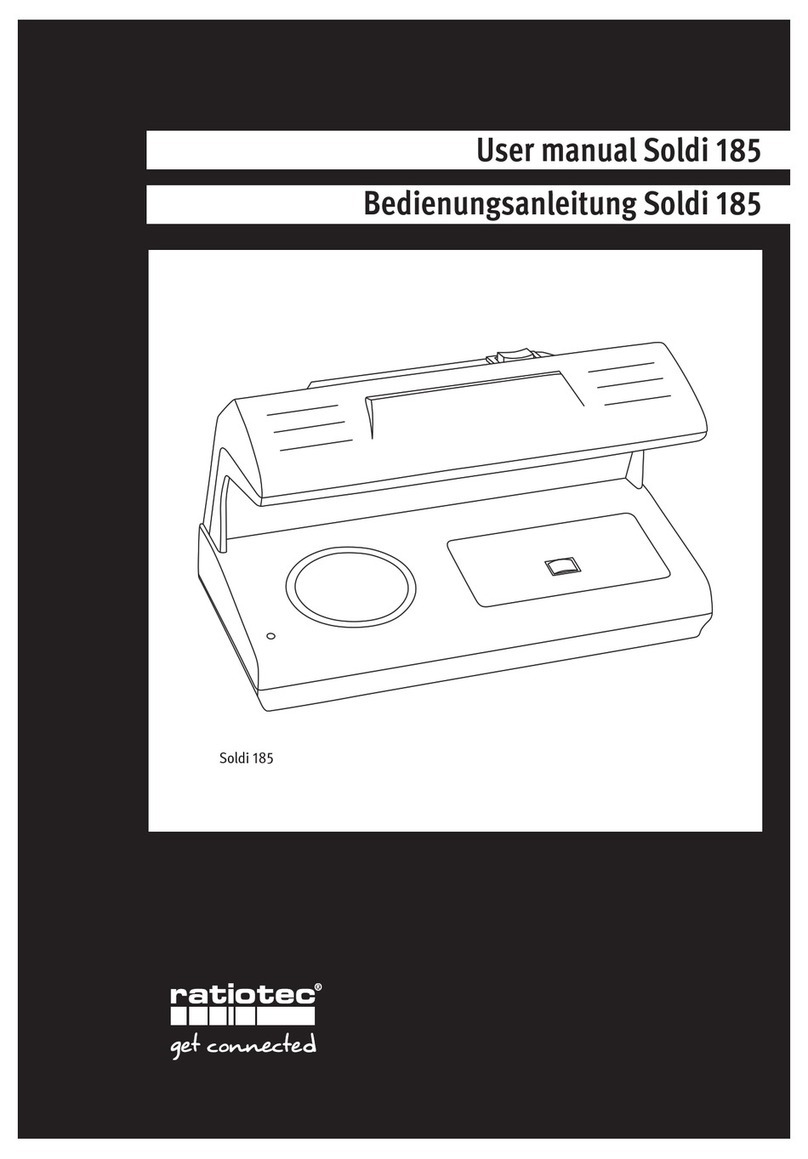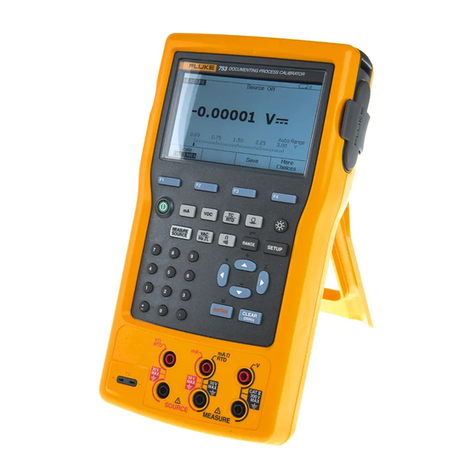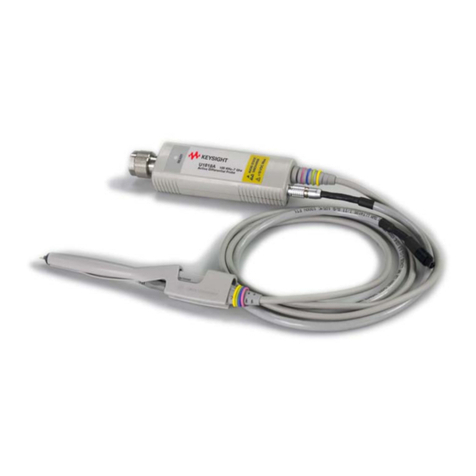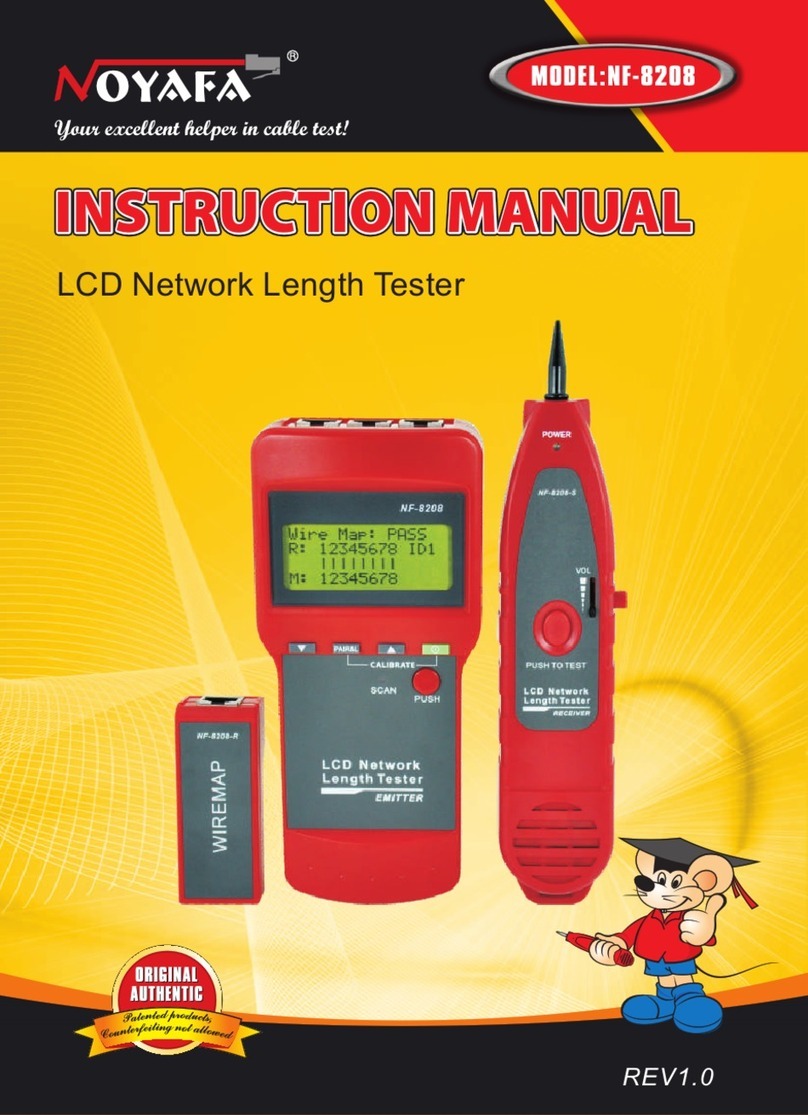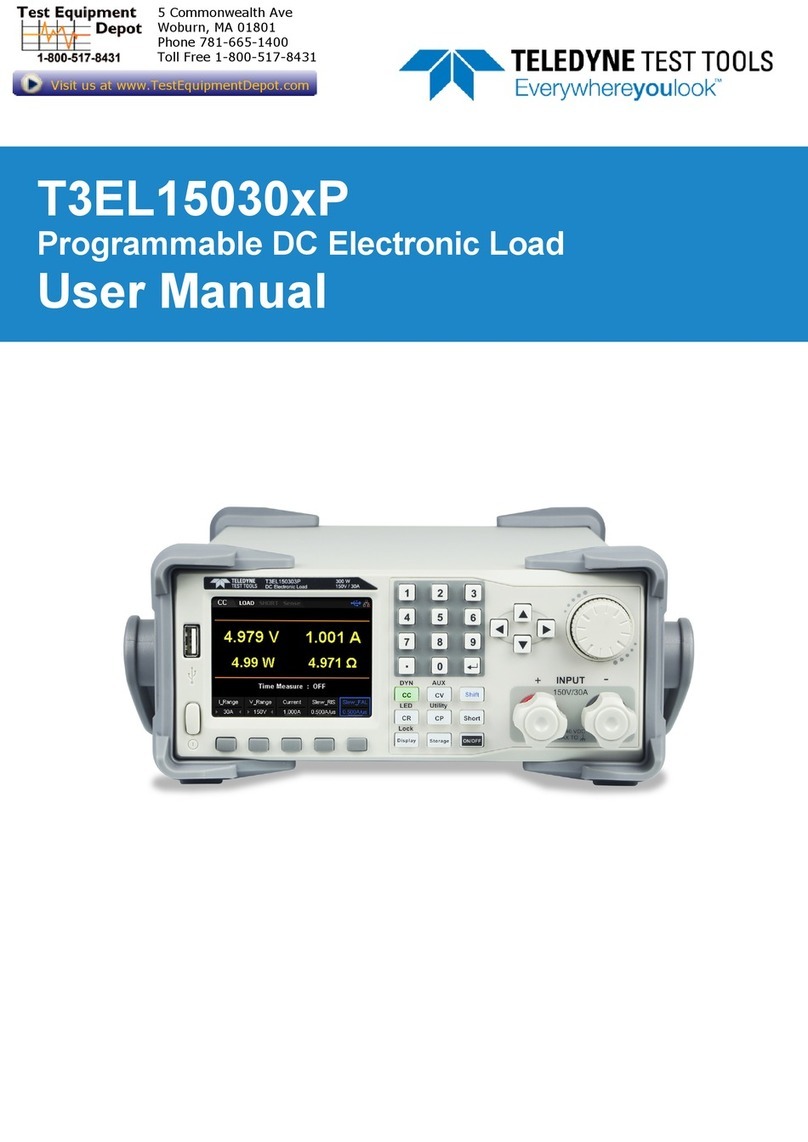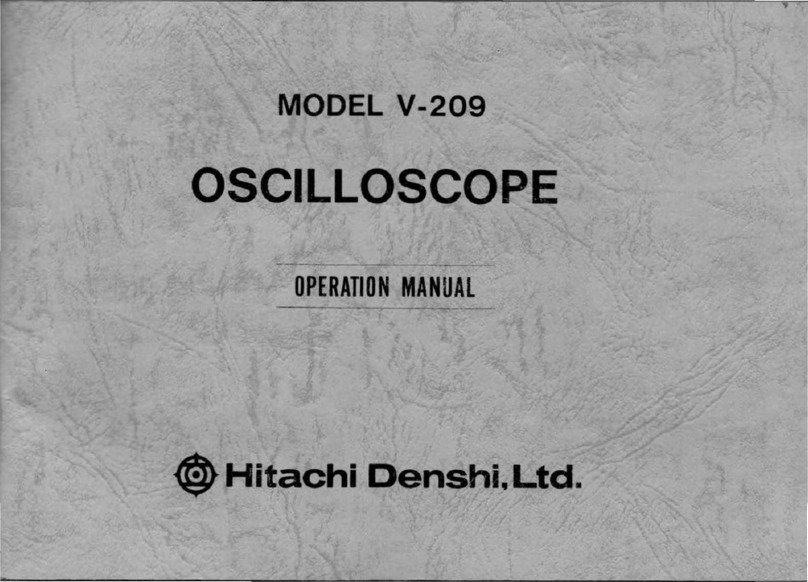Tronic HG01717 User manual

IAN 277662
BATTERIETESTER / BATTERY TESTER /
TESTEUR DE PILES
BATTERIETESTER
Bedienungs- und Sicherheitshinweise
BATTERY TESTER
Operation and safety notes
TESTEUR DE PILES
Instructions d‘utilisation et consignes de sécurité
BATTERIJTESTER
Bedienings- en veiligheidsinstructies
DIGITÁLNÍ ZKOUŠEČKA
BATERIÍ
Pokyny pro obsluhu a bezpečnostní pokyny
COMPROBADOR DE PILAS
Instrucciones de utilización y de seguridad
APARELHO PARA TESTAR
PILHAS
Instruções de utilização e de segurança

DE/AT/CH Bedienungs- und Sicherheitshinweise Seite 5
GB/IE Operation and safety notes Page 11
FR/BE Instructions d‘utilisation et consignes de sécurité Page 17
NL/BE Bedienings- en veiligheidsinstructies Pagina 23
CZ Pokyny pro obsluhu a bezpečnostní pokyny Strana 29
ES Instrucciones de utilización y de seguridad Página 35
PT Instruções de utilização e de segurança Página 41

A
1
2
34
6
5

B
7

5DE/AT/CH
Einleitung............................................................................... Seite 6
Bestimmungsgemäße Verwendung .............. Seite 6
Teilebeschreibung.......................................................... Seite 6
Technische Daten............................................................. Seite 6
Sicherheitshinweise...................................................... Seite 7
Sicherheitshinweise zu Batterien.............................................. Seite 8
Vor der Inbetriebnahme........................................... Seite 8
Batterie einsetzen/wechseln ................................................... Seite 8
Bedienung............................................................................. Seite 9
D, C, AA und AAA Batterie messen ........................................ Seite 9
9 V Batterie messen................................................................... Seite 9
Fehlerbehebung......................................................................... Seite 9
Reinigung und Pflege.................................................. Seite 9
Entsorgung ........................................................................... Seite 10

6 DE/AT/CH
BATTERIETESTER
QEinleitung
Wir beglückwünschen Sie zum Kauf Ihres neuen Produkts. Sie haben sich damit für ein
hochwertiges Produkt entschieden. Die Bedienungsanleitung ist Teil dieses Produkts. Sie enthält
wichtige Hinweise für Sicherheit, Gebrauch und Entsorgung. Machen Sie sich vor der Benutzung
des Produkts mit allen Bedien- und Sicherheitshinweisen vertraut. Benutzen Sie das Produkt nur wie
beschrieben und für die angegebenen Einsatzbereiche. Händigen Sie alle Unterlagen bei
Weitergabe des Produkts an Dritte mit aus.
QBestimmungsgemäße Verwendung
Dieses Gerät ist zur Überprüfung der Restspannung von Batterien und Akkus mit einer Spannung
von 1,5 und 9 Volt bestimmt. Das Gerät darf nur in geschlossenen Räumen verwendet werden.
Dieses Gerät ist nicht für den gewerblichen Einsatz bestimmt.
QTeilebeschreibung
1ausziehbarer Kontaktarm (Batterietypen: D, C, AA, AAA)
2Reset-Taste
3Batteriefachabdeckung
41,5 V-Skala
5Spannungsanzeige
69 V-Skala
7Testkontakte (9 V Batterie)
QTechnische Daten
Messbereich: 0,7 - 1,5 V (Gleichstrom)(Batterietypen: D, C, AA, AAA)
1,8 - 9 V (Gleichstrom) (9 V Batterie)
Spannungsversorgung: 1 x 1,5 V (Gleichstrom) AAA Batterie

7DE/AT/CH
Sicherheitshinweise
J LEBENS- UND UNFALLGEFAHR FÜR KLEINKINDER UND KINDER! Lassen
Sie Kinder niemals unbeaufsichtigt mit dem Verpackungsmaterial. Es besteht
Erstickungsgefahr durch Verpackungsmaterial. Kinder unterschätzen häufig die
Gefahren. Halten Sie Kinder stets vom Produkt fern. Das Produkt ist kein Spielzeug.
J Dieses Gerät kann von Kindern ab 8 Jahren und darüber sowie von Personen mit verringerten
physischen, sensorischen oder mentalen Fähigkeiten oder Mangel an Erfahrung und Wissen
benutzt werden, wenn sie beaufsichtigt oder bezüglich des sicheren Gebrauchs des Gerätes
unterwiesen wurden und die daraus resultierenden Gefahren verstehen. Kinder dürfen nicht mit
dem Gerät spielen. Reinigung und Benutzerwartung dürfen nicht von Kindern ohne
Beaufsichtigung durchgeführt werden.
J Kinder sollten beaufsichtigt werden, um sicherzustellen, dass sie nicht mit dem Gerät spielen.
J Nehmen Sie das Gerät nicht in Betrieb, wenn es beschädigt ist. Beschädigte Geräte bedeuten
Lebensgefahr durch elektrischen Schlag!
J Setzen Sie das Gerät
- keinen extremen Temperaturen,
- starken Vibrationen,
- starken mechanischen Beanspruchungen,
- keiner direkten Sonneneinstrahlung,
- keiner Feuchtigkeit aus.
Andernfalls droht eine Beschädigung des Gerätes.
J Beachten Sie, dass Beschädigungen durch unsachgemäße Handhabung, Nichtbeachtung der
Bedienungsanleitung oder Eingriff durch nicht autorisierte Personen von der Garantie
ausgeschlossen sind.
J Nehmen Sie das Gerät keinesfalls auseinander. Durch unsachgemäße Reparaturen können
erhebliche Gefahren für den Benutzer entstehen. Lassen Sie Reparaturen nur von Fachkräften
durchführen.
J Halten Sie das Produkt stets sauber.
J Setzen Sie das Gerät keiner extremen Hitze bzw. keiner extremen Kälte aus.
J Setzen Sie das Gerät keinen extremen Temperaturschwankungen aus. Andernfalls besteht die
Gefahr, dass sich Kondenswasser bildet. Warten Sie ab, bis das Gerät Zimmertemperatur
erreicht hat, bevor Sie es in Betrieb nehmen.
J Lesen Sie vor Überprüfung die Herstellerhinweise für die jeweilige Batterie durch.

8 DE/AT/CH
Sicherheitshinweise zu Batterien
WARNUNG!LEBENSGEFAHR! Batterien können verschluckt werden, was
lebensgefährlich sein kann. Ist eine Batterie verschluckt worden, muss sofort medizinische Hilfe in
Anspruch genommen werden.
J Entfernen Sie die Batterie, wenn sie längere Zeit nicht verwendet worden ist, aus dem Gerät.
J VORSICHT! EXPLOSIONSGEFAHR! Laden Sie nicht-aufladbare Batterien
niemals wieder auf!
J Achten Sie beim Einlegen auf die richtige Polarität! Diese wird in den Batteriefächern angezeigt.
J Reinigen Sie Batterie- und Gerätekontakt vor dem Einlegen falls erforderlich.
J Entfernen Sie eine erschöpfte Batterie umgehend aus dem Gerät. Es besteht erhöhte Auslaufgefahr!
J Batterien gehören nicht in den Hausmüll!
J Jeder Verbraucher ist gesetzlich verpflichtet, Batterien ordnungsgemäß zu entsorgen!
J Halten Sie Batterien von Kindern fern, werfen Sie sie nicht ins Feuer, schließen Sie sie nicht kurz
und nehmen Sie sie nicht auseinander.
J Bei Nichtbeachtung der Hinweise kann die Batterie über ihre Endspannung hinaus entladen werden.
Es besteht dann die Gefahr des Auslaufens. Falls die Batterie in Ihrem Gerät ausgelaufen sein
sollte, entnehmen Sie diese sofort, um Schäden am Gerät vorzubeugen!
J Vermeiden Sie den Kontakt mit Haut, Augen und Schleimhäuten. Bei Kontakt mit Batteriesäure
spülen Sie die betroffene Stelle mit reichlich Wasser ab und/ oder suchen Sie einen Arzt auf!
QVor der Inbetriebnahme
Q
Batterie einsetzen/wechseln
jEntfernen Sie die Batteriefachabdeckung 3, indem Sie diese in Pfeilrichtung abziehen
(siehe Abbildung).
jLegen Sie eine Batterie vom Typ Micro (AAA 1,5 V) ein.
Hinweis: Achten Sie dabei auf die richtige Polarität. Diese wird im Batteriefach angezeigt.
jSchließen Sie das Batteriefach wieder.

9DE/AT/CH
QBedienung
Q
D, C, AA und AAA Batterie messen
jPlatzieren Sie eine Batterie vom Typ D, C, AA oder AAA im Batterietester (siehe Abb. A).
Hinweis: Achten Sie dabei auf die richtige Polarität. Diese wird am Batterietester angezeigt.
Hinweis: Achten Sie auf den einwandfreien Kontakt zwischen Batterie und Batterietester.
jFixieren Sie die Batterie mittels des ausziehbaren Kontaktarms 1(siehe Abb. A).
jLesen Sie mittels der Spannungsanzeige 5und der 1,5 V-Skala 4die Spannung der
angeschlossenen Batterie ab.
Q
9 V Batterie messen
jPositionieren Sie die 9 V-Batterie an den Testkontakten 7(siehe Abb .B).
Hinweis: Achten Sie dabei auf die richtige Polarität. Diese wird an den Testkontakten 7
angezeigt.
Hinweis: Achten Sie auf den einwandfreien Kontakt zwischen Batterie und Testkontakten 7.
jLesen Sie mittels der Spannungsanzeige 5 und der 9 V-Skala 6die Spannung der
angeschlossenen Batterie ab.
Q
Fehlerbehebung
=Fehler
=Grund
=Lösung
Batterietester reagiert nicht.
Elektrostatische Entladungen können die Funktion des Batterietesters beeinträchtigen.
Drücken Sie die Reset-Taste 2 auf der Rückseite des Batterietesters. Verwenden Sie dafür z.B.
eine Büroklammer o.ä.
Die zu messende Batterie ist verkehrt angelegt.
Legen Sie die zu messende Batterie gemäß korrekter Polung an.
Das Messergebnis ist unwahrscheinlich.
Die Batterie ist nicht korrekt platziert.
Entnehmen Sie die Batterie und warten Sie einige Sekunden oder drücken Sie die Reset-Taste 2 .
Legen Sie die Batterie erneut ein.
QReinigung und Pflege
jReinigen Sie das Gerät nur äußerlich mit einem weichen, trockenen Tuch.
jVerwenden Sie in keinem Fall Flüssigkeiten und keine Reinigungsmittel, da diese das Gerät
beschädigen.

10 DE/AT/CH
QEntsorgung
Die Verpackung besteht aus umweltfreundlichen Materialien, die Sie über die örtlichen
Recyclingstellen entsorgen können.
Möglichkeiten zur Entsorgung des ausgedienten Produkts erfahren Sie bei Ihrer Gemeinde- oder
Stadtverwaltung.
Werfen Sie Ihr Produkt, wenn es ausgedient hat, im Interesse des Umweltschutzes nicht in den
Hausmüll, sondern führen Sie es einer fachgerechten Entsorgung zu. Über Sammelstellen und
deren Öffnungszeiten können Sie sich bei Ihrer zuständigen Verwaltung informieren.
Defekte oder verbrauchte Batterien müssen gemäß Richtlinie 2006/ 66/EG und deren
Änderungen recycelt werden. Geben Sie Batterien und / oder das Gerät über die angebotenen
Sammeleinrichtungen zurück.
Umweltschäden durch falsche Entsorgung der Batterien!
Batterien dürfen nicht über den Hausmüll entsorgt werden. Sie können giftige Schwermetalle enthalten
und unterliegen der Sondermüllbehandlung. Die chemischen Symbole der Schwermetalle sind wie
folgt: Cd = Cadmium, Hg = Quecksilber, Pb = Blei. Geben Sie deshalb verbrauchte Batterien bei
einer kommunalen Sammelstelle ab.

11GB/IE
Introduction............................................................................ Page 12
Proper use................................................................................ Page 12
Description of parts ......................................................... Page 12
Technical data....................................................................... Page 12
Safety Information........................................................... Page 13
Safety Instructions for Batteries................................................... Page 14
Before use................................................................................ Page 14
Insert/ change battery................................................................. Page 14
Operating instructions.................................................. Page 15
Measuring D, C, AA and AAA battery...................................... Page 15
Measuring 9 V battery................................................................. Page 15
Troubleshooting ............................................................................ Page 15
Cleaning and maintenance....................................... Page 15
Disposal...................................................................................... Page 16

12 GB/IE
BATTERY TESTER
Introduction
We congratulate you on the purchase of your new product. You have chosen a high quality
product. The instructions for use are part of the product. They contain important information
concerning safety, use and disposal. Before using the product, please familiarise yourself with all of
the safety information and instructions for use. Only use the unit as described and for the specified
applications. If you pass the product on to anyone else, please ensure that you also pass on all the
documentation with it.
QProper use
This device is intended for checking the residual voltage of disposable and rechargeable batteries
with a voltage of 1.5 and 9 volts. The product is intended for indoor use only. The product is not
intended for commercial use.
QDescription of parts
1extendable contact arm (battery types: D, C, AA, AAA)
2reset button
3battery compartment cover
41.5 V scale
5voltage display
69 V scale
7test contacts (9 V battery)
QTechnical data
Measurement range: 0.7 - 1.5 V (direct current) (battery types: D, C, AA, AAA)
1.8 - 9 V (direct current) (9 V battery)
Power supply: 1 x 1.5 V (direct current) AAA battery

13GB/IE
Safety Information
J DANGER TO LIFE AND ACCIDENT HAZARD FOR TODDLERS AND
SMALL CHILDREN! Never allow children to play unsupervised with the packaging
material. There is a danger of suffocation from the packaging material. Children
frequently underestimate the dangers. Children should be kept away from the product at all
times. This product is not a toy.
J This appliance can be used by children aged from 8 years and above and persons with
reduced physical, sensory or mental capabilities or lack of experience and knowledge if they
have been given supervision or instruction concerning use of the appliance in a safe way and
understand the hazards involved. Children shall not play with the appliance. Cleaning and user
maintenance shall not be made by children without supervision.
J Children must never be allowed to play with the device.
J Do not use the device if it is damaged. Damaged devices represent a danger of death from
electric shock!
J Do not expose the device to
- extreme temperatures,
- strong vibrations,
- heavy mechanical loads,
- direct sunlight,
- moisture.
Otherwise there is a danger that the device will be damaged.
J Please note that the guarantee does not cover damage caused by incorrect handling, non-
compliance with the operating instructions or interference with the device by unauthorised
individuals.
J Under no circumstances should you take the device apart. Improper repairs may place the user
in considerable danger. Repairs should only be carried out by specialist personnel.
J Please keep the product clean.
J Do not allow the product to be subjected to extreme heat or cold.
J Do not allow the product to be subjected to extreme temperature fluctuations. Failure to observe
this advice could lead to condensation forming. Wait until the product has reached temperature
of the room before you use it.
J Before inspection, please read the manufacturer’s instructions for the respective battery.

14 GB/IE
Safety Instructions for Batteries
WARNING! DANGER TO LIFE! Batteries can be swallowed, which may represent a
danger to life. If a battery has been swallowed, medical help is required immediately.
J Remove the battery from the device when it has not been used for a longer period of time.
J CAUTION! DANGER OF EXPLOSION! Non-rechargeable batteries must never
be recharged!
J When inserting the battery, ensure the correct polarity! This is shown in the battery compartments.
J If necessary, clean the battery and device contacts before inserting the battery.
J Remove a spent battery immediately from the device. There
is an increased danger of leaks!
J Batteries must not be disposed of in the normal domestic waste!
J Every consumer is legally obliged to dispose of batteries in the proper manner!
J Keep batteries away from children; do not throw them in the fire, short-circuit them or take them
apart.
J If the above instructions are not complied with, the battery may discharge themselves beyond
their end voltage. There is then a danger of leaking. If the battery have leaked inside your
device, you should remove them immediately in order to prevent damage to the device!
J Avoid contact with the skin, eyes and mucous membranes. Any parts of the body coming into
contact with battery acid should be rinsed off with copious amounts of water and/or a doctor
contacted if necessary!
QBefore use
Q
Insert/change battery
jRemove the cover of the battery compartment 3by pulling it off in the direction of the arrow
(see illustration).
jInsert a micro battery (AAA 1.5 V).
Note: Please observe the correct polarity. This is indicated in the battery compartment.
jThen close the battery compartment again.

15GB/IE
QOperating instructions
Q
Measuring D, C, AA and AAA battery
jPlace a battery of the type D, C, AA or AAA in the battery tester (see fig. A).
Note: In doing so, please observe the correct polarity. This is shown on the battery tester.
Note: Please ensure for proper contact between the battery and the battery tester.
jSecure the battery by means of the extendable contact arm 1(see fig. A).
jRead the voltage of the connected battery using the voltage display 5and the 1.5 V scale 4.
Q
Measuring 9 V battery
jPosition the 9 V battery on the test contacts 7(see fig. B).
Note: In doing so, please observe the correct polarity. This is shown on the test contacts 7.
Note: Please ensure for proper contact between the battery and the test contacts 7.
jRead the voltage of the connected battery using the voltage display 5and the 9 V scale 6.
Q
Troubleshooting
=Fault
=Cause
=Solution
Battery tester does not react.
Electrostatic discharge can affect the function of the battery tester.
Press the reset button 2on the back of the battery tester. For this purpose a paper clip or a
similar object can be used.
The battery to be tested has been inserted incorrectly.
Insert the battery to be tested according to the correct polarity.
The resulting measurement is unlikely.
The battery has not been inserted properly.
Remove the battery and wait for a few seconds, or press the reset button 2. Reinsert the battery.
Q
Cleaning and maintenance
jThe device should only be cleaned on the outside with a soft dry cloth.
jUnder no circumstances should you use liquids or detergents, as these will damage the device.

16 GB/IE
QDisposal
The packaging is made entirely of recyclable materials, which you may dispose of at local recycling
facilities.
Contact your local refuse disposal authority for more details of how to dispose of your worn-out
product. To help protect the environment, please dispose of the product properly when it has
reached the end of its useful life and not in the household waste. Information on
collection points and their opening hours can be obtained from your local authority.
Faulty or used batteries must be recycled in accordance with Directive 2006 / 66 / EC and its
amendments. Return the battery and/ or the device through the appropriate collection facilities.
Environmental damage through incorrect disposal of the batteries!
Batteries may not be disposed of with the usual domestic waste. They may contain toxic heavy
metals and are subject to hazardous waste treatment rules and regulations. The chemical symbols
for heavy metals are as follows: Cd = cadmium, Hg= mercury, Pb = lead. That is why you should
dispose of used batteries at a local collection point.

17FR/BE
Introduction............................................................................. Page 18
Utilisation conforme à l‘usage prévu ............... Page 18
Descriptif des pièces......................................................... Page 18
Données techniques ........................................................ Page 18
Consignes de sécurité.................................................... Page 18
Consignes de sécurité relatives aux piles................................... Page 19
Avant la mise en marche............................................. Page 20
Placer/remplacer la pile............................................................. Page 20
Utilisation................................................................................. Page 20
Mesurer des piles D, C, AA et AAA ........................................... Page 20
Mesurer des piles 9 V .................................................................. Page 21
Résolution des erreurs .................................................................. Page 21
Nettoyage et entretien................................................. Page 21
Recyclage.................................................................................. Page 21

18 FR/BE
TESTEUR DE PILES
Introduction
Nous vous félicitons pour l’achat de votre nouveau produit. Vous avez opté pour un produit de
grande qualité. Le mode d‘emploi fait partie intégrante de ce produit. Il contient des indications
importantes pour la sécurité, l’utilisation et la mise au rebut. Veuillez lire consciencieusement toutes
les indications d‘utilisation et de sécurité du produit. Ce produit doit uniquement être utilisé
conformément aux instructions et dans les domaines d‘application spécifiés. Lors d‘une cession à
tiers, veuillez également remettre tous les documents.
Utilisation conforme à l‘usage prévu
Cet appareil est destiné a la vérification de le tension restante de piles et d‘accus avec une tension
de 1,5 et 9 Volt. L‘appareil est uniquement a utiliser a l‘intérieur de pičces fermées. Ce produit n‘est
pas destiné a l‘usage professionnel.
Descriptif des pièces
1Bras de contact télescopique (types de piles : D, C, AA, AAA)
2Touche de reset
3Couvercle du compartiment à piles
4Graduation 1,5 V
5Affichage de tension
6Graduation 9 V
7Contacts de test (piles 9 V)
Données techniques
Domaine de prise de mesure : 0,7 - 1,5 V (courant continu) (types de piles : D, C, AA, AAA)
1,8 - 9 V (courant continu) (piles 9 V)
Alimentation de tension : 1 x 1,5 V (courant continu) pile AAA
Consignes de sécurité
J DANGER DE MORT ET D’ACCIDENT POUR LES ENFANTS EN BAS ÂGE
ET LES ENFANTS ! Ne jamais laisser les enfants manipuler sans surveillance le
matériel d’emballage. Il existe un risque d’étouffement par le matériel d’emballage.
Les enfants sousestiment souvent les dangers. Toujours tenir les enfants à l’écart du produit. Ce
produit n‘est pas un jouet.

19FR/BE
J Cet appareil peut être utilisé par des enfants de 8 ans et plus ainsi que par des personnes à
capacités physiques, sensorielles ou mentales réduites ou manquant d‘expérience et de
connaissance que sous surveillance ou s‘ils ont été instruits de l‘utilisation sûre de cet appareil
et des risques en découlant. Les enfants ne doivent pas jouer avec cet appareil. Le nettoyage et
la maintenance domestique de l‘appareil ne doit pas être effectué par un enfant sans
surveillance.
J Il convient de surveiller les enfants de manière à ce qu’ils ne jouent pas avec l’appareil.
J Ne mettez pas l‘appareil en service s‘il est endommagé. Des appareils endommagés impliquent
un danger de mort par électrocution!
J N‘exposez pas l‘appareil
- à des températures extrêmes,
- à des vibrations importantes,
- à des sollicitations mécaniques importantes,
- aux rayons directs du soleil,
- à l’humidité.
Risque d’endommagement de l’appareil dans le cas contraire.
J N‘oubliez pas que sont exclus de la garantie les endommagements résultant d‘une manipulation
incorrecte, du non respect du mode d‘emploi ou de l‘intervention sur l‘appareil de personnes non
autorisées.
J Ne démontez en aucun cas l‘appareil. Des réparations incorrectes peuvent être la source de
dangers importants pour l’utilisateur. Ne faites effectuer toutes réparations que par des spécialistes.
J Veillez à ce que le produit soit toujours propre.
J N‘exposez pas l‘appareil a de la chaleur ou du froid extręme.
J Veuillez ne pas exposer le produit a des variations extręmes de température. Autrement, vous
risquez la formation d‘eau de condensation. Veuillez patienter jusqu‘a ce que l‘appareil ait
atteint la température ambiante, avant de le mettre en marche.
J Veuillez lire les indications des fabricants pour les piles correspondantes.
Consignes de sécurité relatives aux piles
AVERTISSEMENT ! DANGER DE MORT ! Les piles peuvent être avalées, ce qui
peut être mortel. En cas d’ingurgitation d’une pile, il faut immédiatement consulter un médecin.
JRetirer la pile de l‘appareil, si elle n‘a pas été utilisée depuis longtemps.
JATTENTION ! DANGER D‘EXPLOSION ! Ne rechargez jamais des piles
rechargeables !

20 FR/BE
JVeiller à insérer la pile en respectant la polarité correcte ! Celle-ci est indiquée dans le boîtier à
piles.
JAu besoin, nettoyer les contacts des piles et de l’appareil avant l’insertion.
J
Immédiatement enlever les piles usées de l’appareil. Il existe un risque élevé de coulage des piles !
JNe pas jeter les piles dans les ordures ménagères !
JChaque consommateur est tenu par la loi à mettre les piles au rebut de manière adéquate !
JTenir les piles à l’écart des enfants, ne pas les jeter dans un feu, ni les court-circuiter ou les démonter.
JEn cas de non respect de ces instructions, les piles peuvent décharger au-delà de leur tension
finale. Elles risquent alors de couler. Si les piles coulent dans votre appareil, il faut immédiatement
les retirer pour prévenir tout endommagement du produit !
JÉviter tout contact avec la peau, les yeux et les muqueuses. En cas de contact avec l’acide,
rincer abondamment la zone à l’eau claire et/ ou contacter un médecin !
Avant la mise en marche
QPlacer/remplacer la pile
jRetirer le couvercle du boîtier des piles 3en le relevant dans le sens indiqué par la flèche
(voir illustration).
jPlacez une pile de type micro (AAA 1,5 V).
Indication : Veuillez respecter la bonne polarité. Celle-ci est affichée dans le compartiment a
piles.
jRefermez le compartiment à piles.
Utilisation
QMesurer des piles D, C, AA et AAA
jPlacez une pile de type D, C, AA ou AAA dans le testeur de piles (voir ill. A).
Indication : Veuillez respecter la bonne polarité. Celle-ci est indiquée sur le testeur de piles.
Indication : Veillez à un bon contact entre pile et testeur de piles.
jFixez la pile à l‘aide du bras de contact télescopique 1(voir ill. A).
jÀ l‘aide de l‘affichage de tension 5et de la graduation de 1,5 V 4vous pouvez lire la
tension de la pile branchée.
This manual suits for next models
1
Table of contents
Languages:
Other Tronic Test Equipment manuals
